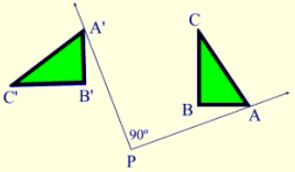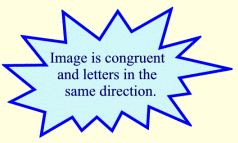Rotations
A rotation is a transformation that turns a figure about a fixed point called the center of rotation. Rays drawn from the center of rotation to a point and its image form an angle called the angle of rotation. (notation Rdegrees )
 An object and its rotation are the same shape and size, but the figures may be turned in different directions.
An object and its rotation are the same shape and size, but the figures may be turned in different directions.
Properties preserved (invariant) under a rotation:
- distance is preserved (lengths of segments are the same)
- angle measures (remain the same)

- parallelism (parallel lines remain parallel)
- colinearity (points stay on the same lines)
- midpoint (midpoints remain the same in each figure)
- orientation (lettering order remains the same)

So what is this definition saying:
Part I (up to the word “and”): Here we see an example where the angle is 90 degrees. The center of rotation is point P and point A is distinct from point P. In addition to point A, we also have points B and C forming triangle ABC.
 Part II (after the word “and”): The second part of the definition deals with point P being rotated about itself. Rotating a POINT about itself creates no noticeable changes. The image from this rotation will be the same point P that you started with. This is represented by RP,θ(P) = P
Part II (after the word “and”): The second part of the definition deals with point P being rotated about itself. Rotating a POINT about itself creates no noticeable changes. The image from this rotation will be the same point P that you started with. This is represented by RP,θ(P) = P
A rotation turns a figure through an angle about a fixed point called the center.
When working in the coordinate plane, assume the center of rotation to be the origin unless told otherwise. A positive angle of rotation turns the figure counterclockwise, and a negative angle of rotation turns the figure in a clockwise direction.

